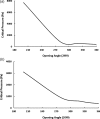Effect of Axial Stretch on Lumen Collapse of Arteries
- PMID: 27657334
- PMCID: PMC5125316
- DOI: 10.1115/1.4034785
Effect of Axial Stretch on Lumen Collapse of Arteries
Abstract
The stability of the arteries under in vivo pressure and axial tension loads is essential to normal arterial function, and lumen collapse due to buckling can hinder the blood flow. The objective of this study was to develop the lumen buckling equation for nonlinear anisotropic thick-walled arteries to determine the effect of axial tension. The theoretical equation was developed using exponential Fung strain function, and the effects of axial tension and residual stress on the critical buckling pressure were illustrated for porcine coronary arteries. The buckling behavior was also simulated using finite-element analysis. Our results demonstrated that lumen collapse of arteries could occur when the transmural pressure is negative and exceeded a critical value. This value depends upon the axial stretch ratio and material properties of the arterial wall. Axial tensions show a biphasic effect on the critical buckling pressure. The lumen aspect ratio of arteries increases nonlinearly with increasing external pressure beyond the critical value as the lumen collapses. These results enhance our understanding of artery lumen collapse behavior.
Figures




Similar articles
-
Computational simulations of the helical buckling behavior of blood vessels.Int J Numer Method Biomed Eng. 2019 Dec;35(12):e3277. doi: 10.1002/cnm.3277. Epub 2019 Nov 27. Int J Numer Method Biomed Eng. 2019. PMID: 31680465 Free PMC article.
-
Twist buckling of veins under torsional loading.J Biomech. 2017 Jun 14;58:123-130. doi: 10.1016/j.jbiomech.2017.04.018. Epub 2017 May 5. J Biomech. 2017. PMID: 28526174 Free PMC article.
-
Buckling of Arteries With Noncircular Cross Sections: Theory and Finite Element Simulations.Front Physiol. 2021 Aug 13;12:712636. doi: 10.3389/fphys.2021.712636. eCollection 2021. Front Physiol. 2021. PMID: 34483964 Free PMC article.
-
Fluid-structure interaction modeling of aneurysmal arteries under steady-state and pulsatile blood flow: a stability analysis.Comput Methods Biomech Biomed Engin. 2018 Feb;21(3):219-231. doi: 10.1080/10255842.2018.1439478. Epub 2018 Feb 15. Comput Methods Biomech Biomed Engin. 2018. PMID: 29446991 Free PMC article.
-
Artery buckling: new phenotypes, models, and applications.Ann Biomed Eng. 2013 Jul;41(7):1399-410. doi: 10.1007/s10439-012-0707-0. Epub 2012 Nov 29. Ann Biomed Eng. 2013. PMID: 23192265 Free PMC article. Review.
Cited by
-
Comparison of Biomechanical Properties and Microstructure of Trabeculae Carneae, Papillary Muscles, and Myocardium in the Human Heart.J Biomech Eng. 2019 Feb 1;141(2):0210071-02100710. doi: 10.1115/1.4041966. J Biomech Eng. 2019. PMID: 30418486 Free PMC article.
-
Lack of chronic neuroinflammation in the absence of focal hemorrhage in a rat model of low-energy blast-induced TBI.Acta Neuropathol Commun. 2017 Nov 10;5(1):80. doi: 10.1186/s40478-017-0483-z. Acta Neuropathol Commun. 2017. PMID: 29126430 Free PMC article.
-
Mechanical analysis of a novel biodegradable zinc alloy stent based on a degradation model.Biomed Eng Online. 2019 Apr 2;18(1):39. doi: 10.1186/s12938-019-0661-2. Biomed Eng Online. 2019. PMID: 30940146 Free PMC article.
-
Computational simulations of the helical buckling behavior of blood vessels.Int J Numer Method Biomed Eng. 2019 Dec;35(12):e3277. doi: 10.1002/cnm.3277. Epub 2019 Nov 27. Int J Numer Method Biomed Eng. 2019. PMID: 31680465 Free PMC article.
-
Twist buckling of veins under torsional loading.J Biomech. 2017 Jun 14;58:123-130. doi: 10.1016/j.jbiomech.2017.04.018. Epub 2017 May 5. J Biomech. 2017. PMID: 28526174 Free PMC article.
References
-
- Fung, Y. C. , 1997, Biomechanics: Circulation, Springer, New York: 10.1007/978-1-4757-2696-1 - DOI
-
- Lee, M. S. , and Chen, C. H. , 2015, “ Myocardial Bridging: An Up-to-Date Review,” J. Invasive Cardiol., 27(11), pp. 521–528.https://www.ncbi.nlm.nih.gov/pmc/articles/PMC4818117/ - PMC - PubMed
-
- Corban, M. T. , Hung, O. Y. , Eshtehardi, P. , Rasoul-Arzrumly, E. , McDaniel, M. , Mekonnen, G. , Timmins, L. H. , Lutz, J. , Guyton, R. A. , and Samady, H. , 2014, “ Myocardial Bridging: Contemporary Understanding of Pathophysiology With Implications for Diagnostic and Therapeutic Strategies,” J. Am. Coll. Cardiol., 63(22), pp. 2346–2355.10.1016/j.jacc.2014.01.049 - DOI - PMC - PubMed
Publication types
MeSH terms
Grants and funding
LinkOut - more resources
Full Text Sources
Other Literature Sources

